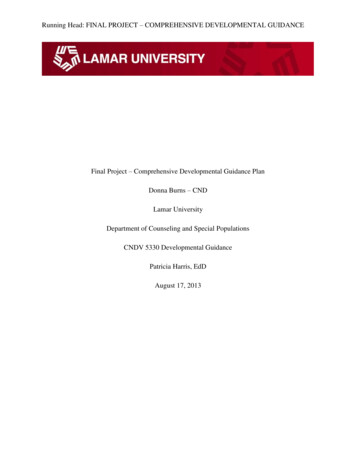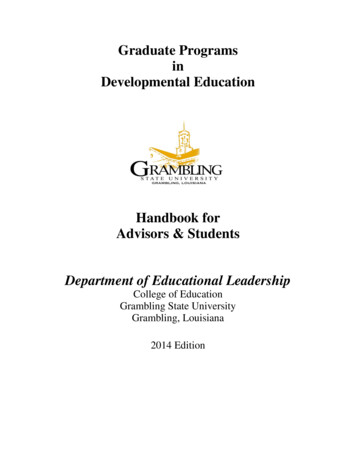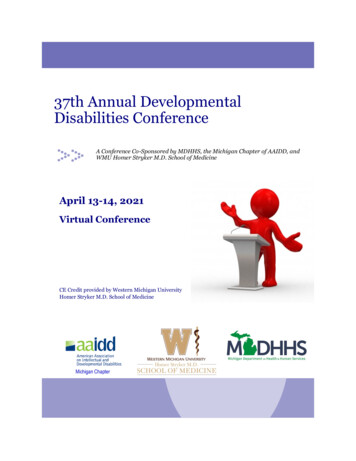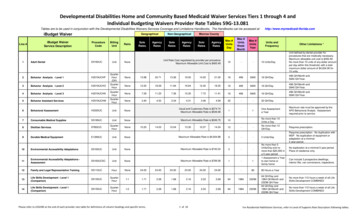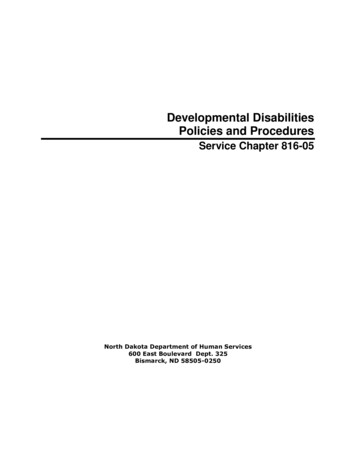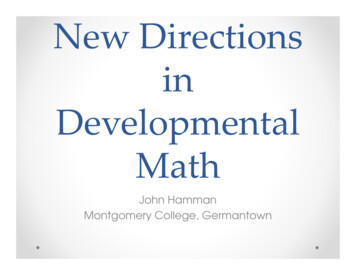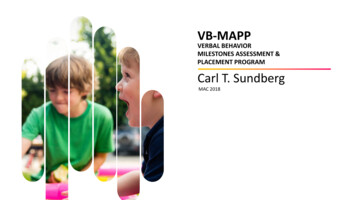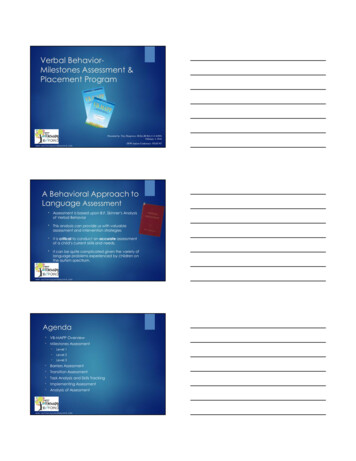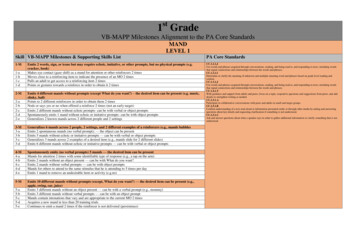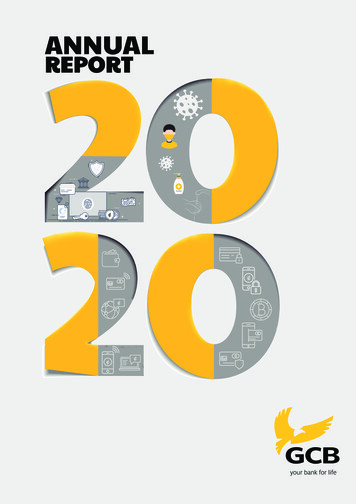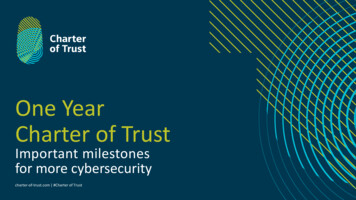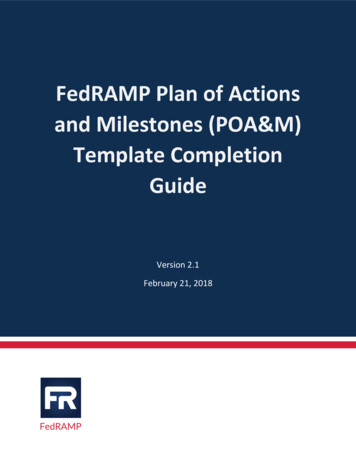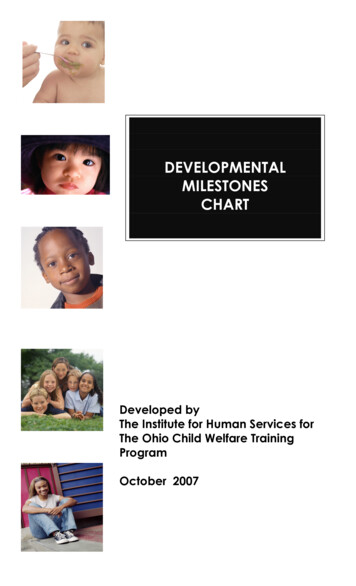
Transcription
DEVELOPMENTALMILESTONESCHARTDeveloped byThe Institute for Human Services forThe Ohio Child Welfare TrainingProgramOctober 2007
How to Use This ChartOverview:This developmental milestones chart isdesigned specifically for Children Services staff.It includes normal expectations ofdevelopmental milestones for children birththrough adolescence, and information aboutthe possible effects of maltreatment.How To Use:Caseworkers and other CPS professionals willfind many ways to use this chart. Below aresome suggestions: Review the chart prior to scheduledinteractions with children to prompt yourrecall of common milestones and to helpyou identify potential developmental delaysor concerns. Copy the chart that corresponds to the ageof the child you will be seeing, and use it toassess the child’s achievement of milestonesand apparent delays. Circle apparentdelays, or developmental areas needingfurther assessment.
Infants and ToddlersPhysicalCognitiveNewborn: rough, random, Sensori-motor: physicallyuncoordinated,explores environmentreflexive movementto learn about it;repeats movements to3 mo: head at 90 degreemaster them, whichangle, uses arms toalso stimulates brainprop; visually trackcell developmentthrough midline4-5 mo: coos, curious5 mo: purposeful grasp;and interested inroll over; head lagenvironmentdisappears; reaches forobjects; transfer objects 6 mo: babbles andfrom hand to hand;imitates soundsplays with feet;exercises body by9 mo: discriminatesstretching, moving;between parents andtouch genitals, rock onothers; trial and errorstomach for pleasureproblem solving7 mo: sits in “tripod”; pushhead and torso up offthe floor; supportweight on legs;“raking” with hands9 mo: gets to and fromsitting; crawls, pulls tostanding; stooping andrecovering; fingerthumb opposition; eyehand coordination, butno hand preference12 mo: walking15 mo: more complexmotor skills2 yrs: learns to climb upstairs first, then down12 mo: beginning ofsymbolic thinking;points to pictures inbooks in response toverbal cue; objectpermanence; somemay use single words;receptive languagemore advanced thanexpressive language15 mo: learns throughimitating complexbehaviors; knowsobjects are used forspecific purposes2 yrs: 2 word phrases;uses more complextoys and understandssequence of puttingtoys, puzzles togetherSocialAttachment: babysettles when parentcomforts; toddlerseeks comfort fromparent, safe-baseexploration5 mo: responsive tosocial stimuli; facialexpressions ofemotion9 mo: sociallyinteractive; playsgames (i.e., pattycake) withcaretakers11 mo: strangeranxiety; separationanxiety; solitary play2 yr: imitation, paralleland symbolic, play
EmotionalPossible effects of maltreatmentBirth-1 yr: learns fundamental trust Chronic malnutrition: growth retardation,in self, caretakers, environmentbrain damage, possibly mentalretardation1-3 yr: mastery of body andrudimentary mastery ofHead injury and shaking: skull fracture,environment (can get other’s tomental retardation, cerebral palsy,take care of him)paralysis, coma, death, blindness,deafness12-18 mo: “terrible twos” maybegin; willful, stubborn, tantrums Internal organ injuries18-36 mo: feel pride when theyare “good” andembarrassment when they are“bad”Chronic illness from medical neglect18-36 mo: Can recognize distressin others – beginning ofempathyLanguage and speech delays; may notuse language to communicate18-36 mo: are emotionallyattached to toys or objects forsecurityDelays in gross and fine motor skills, poormuscle toneInsecure or disorganized attachment:overly clingy, lack of discrimination ofsignificant people, can’t use parent assource of comfortPassive, withdrawn, apathetic,unresponsive to others“Frozen watchfulness”, fearful, anxious,depressedFeel they are “bad”Immature play – cannot be involved inreciprocal, interactive play
PreschoolPhysicalPhysically activeCognitiveEgo-centric, illogical, magicalthinkingRule of Three: 3 yrs,3 ft, 33 lbs.Explosion of vocabulary;learning syntax, grammar;Weight gain: 4-5 lbsunderstood by 75% ofper yearpeople by age 3Growth: 3-4 inchesper yearPoor understanding of time,value, sequence of eventsPhysically active,can’t sit still forlongVivid imaginations; somedifficulty separating fantasyfrom realityClumsy throwingballsAccurate memory, but moresuggestible than olderchildrenRefines complexskills: hopping,Primitive drawing, can’tjumping,represent themselves inclimbing,drawing till age 4running, ride “bigwheels” andDon’t realize others havetricyclesdifferent perspectiveImproving fineLeave out important factsmotor skills andeye-handMay misinterpret visual cues ofcoordination: cutemotionswith scissors,draw shapesReceptive language betterthan expressive till age 43– 3 ½ yr: mosttoilet trainedSocialPlay: Cooperative,imaginative, mayinvolve fantasyand imaginaryfriends, takes turnsin games Develops grossand fine motorskills; social skills;experiment withsocial roles;reduces fearsWants to pleaseadultsDevelopment ofconscience:incorporatesparentalprohibitions; feelsguilty whendisobedient;simplistic idea of“good and bad”behaviorCurious about his andother’s bodies, maymasturbateNo sense of privacyPrimitive, stereotypicunderstanding ofgender roles
EmotionalSelf-esteem based onwhat others tell himor herPossible effects of maltreatmentPoor muscle tone, motor coordinationPoor pronunciation, incomplete sentencesIncreasing ability toCognitive delays; inability to concentratecontrol emotions; lessemotional outburstsCannot play cooperatively; lack curiosity, absentimaginative and fantasy playIncreased frustrationtoleranceSocial immaturity: unable to share or negotiate withpeers; overly bossy, aggressive, competitiveBetter delaygratificationAttachment problems: overly clingy, superficialattachments, show little distress or over-react whenRudimentary sense ofseparated from caregiverselfUnderweight from malnourishment; small statureUnderstands conceptsof right and wrongExcessively fearful, anxious, night terrorsSelf-esteem reflectsopinions ofsignificant othersCuriousSelf-directed in manyactivitiesReminders of traumatic experience may triggersevere anxiety, aggression, preoccupationLack impulse control, little ability to delay gratificationExaggerated response (tantrums, aggression) to evenmild stressorsPoor self esteem, confidence; absence of initiativeBlame self for abuse, placementPhysical injuries; sickly, untreated illnessesEneuresis, encopresis, self stimulating behavior –rocking, head-banging
School AgedPhysicalCognitiveSocialSlow, steady growth:3 -4 inches per yearUse language as acommunication toolUse physical activitiesto develop grossand fine motor skillsPerspective taking:Understands concepts5-8 yr: can recognizeof right and wrongothers’ perspectives,can’t assume the role of Rules relied upon tothe otherguide behavior and8–10 yr: recognizeplay, and providedifference betweenchild with structurebehavior and intent; ageand security10-11 yr: can accuratelyrecognize and consider5-6 yr: believe rules canothers’ viewpointsbe changedMotor & perceptualmotor skills betterintegrated10-12 yr: pubertybegins for somechildrenConcrete operations:Accurate perception ofevents; rational, logicalthought; concretethinking; reflect upon selfand attributes;understands concepts ofspace, time, dimensionCan remember eventsfrom months, or yearsearlierMore effective coping skillsUnderstands how hisbehavior affects othersFriendships are situationspecific7-8 yrs: strict adherenceto rules9-10 yrs: rules can benegotiatedBegin understandingsocial roles; regardsthem as inflexible; canadapt behavior to fitdifferent situations;practices social rolesTakes on moreresponsibilities athomeLess fantasy play, moreteam sports, boardgamesMorality: avoidpunishment; selfinterested exchanges
EmotionalSelf esteem based on abilityto perform and produceAlternative strategies fordealing with frustrationand expressing emotionsSensitive to other’s opinionsabout themselves6-9 yr: have questions aboutpregnancy, intercourse,sexual swearing, look fornude pictures in books,magazinesPossible effects of maltreatmentPoor social/academic adjustment in school:preoccupied, easily frustrated, emotionaloutbursts, difficulty concentrating, can beoverly reliant on teachers; academicchallenges are threatening, cause anxietyLittle impulse control, immediate gratification,inadequate coping skills, anxiety, easilyfrustrated, may feel out of controlExtremes of emotions, emotional numbing; olderchildren may “self-medicate” to avoidnegative emotionsAct out frustration, anger, anxiety with hitting,fighting, lying, stealing, breaking objects,10-12 yr: games with peeing,verbal outbursts, swearingsexual activity (e.g., strippoker, truth/dare, boy-girl Extreme reaction to perceived danger (i.e.,relationships, flirting, some“fight, flight, freeze” response)kissing, stroking/rubbing,re-enacting intercourseMay be mistrustful of adults, or overly solicitous,with clothes on)manipulativeMay speak in unrealistically glowing terms abouthis parentsDifficulties in peer relationships; feel inadequatearound peers; over-controllingUnable to initiate, participate in, or completeactivities, give up quicklyAttachment problems: may not be able to trust,tests commitment of foster and adoptiveparent with negative behaviorsRole reversal to please parents, and take care ofparent and younger siblingsEmotional disturbances: depression, anxiety,post traumatic stress disorder, attachmentproblems, conduct disorders
AdolescentsPhysicalGrowth spurt:Girls: 11-14 yrsBoys: 13-17 yrsCognitiveSocialFormal operations: precursors in Young (12 – 14):early adolescence, morepsychologicallydeveloped in middle anddistance self fromlate adolescence, as follows:parents; identifyPuberty:with peer group;Girls: 11-14 yrsThink hypothetically: calculatesocial status largelyBoys: 12-15 yrsconsequences of thoughtsrelated to groupand actions withoutmembership; socialYouth acclimate toexperiencing them; consideracceptancechanges in bodya number of possibilities anddepends onplan behavior accordinglyconformity toobservable traits orThink logically: identify androles; need to bereject hypotheses or possibleindependent fromoutcomes based on logicall adults;ambivalent aboutThink hypothetically, abstractly,sexual relationships,logicallysexual behavior isexploratoryThink about thought: leads tointrospection and selfMiddle (15 – 17):analysisfriendships basedon loyalty,Insight, perspective taking:understanding,understand and considertrust; self-revelationothers’ perspectives, andis first step towardsperspectives of socialintimacy; conscioussystemschoices aboutadults to trust;Systematic problem solving:respect honesty &can attack a problem,straightforwardnessconsider multiple solutions,from adults; mayplan a course of actionbecome sexuallyactiveCognitive development isuneven, and impacted byMorality: golden rule;emotionalityconformity with lawis necessary forgood of society
EmotionalPsycho-social task is identityformationPossible effects of maltreatmentAll of the problems listed in school agesectionYoung adolescents (12-14): selfIdentity confusion: inability to trust in self toconscious about physicalbe a healthy adult; expect to fail; mayappearance and early or lateappear immobilized and withoutdevelopment; body imagedirectionrarely objective, negativelyaffected by physical and sexual Poor self esteem: pervasive feelings of guilt,abuse; emotionally labile; mayself-criticism, overly rigid expectations forover-react to parentalself, inadequacyquestions or criticisms; engagein activities for intenseMay overcompensate for negative selfemotional experience; riskyesteem by being narcissistic,behavior; blatant rejections ofunrealistically self-complimentary;parental standards; rely on peergrandiose expectations for selfgroup for supportMay engage in self-defeating, testing, andMiddle adolescents (15-17):aggressive, antisocial, or impulsiveexamination of others’ values,behavior; may withdrawbeliefs; forms identity byorganizing perceptions of ones Lack capacity to manage intenseattitudes, behaviors, values intoemotions; may be excessively labile, withcoherent “whole”; identityfrequent and violent mood swingsincludes positive self imagecomprised of cognitive andMay be unable to form or maintainaffective componentssatisfactory relationships with peersAdditional struggles with identityEmotional disturbances: depression,formation include minority or bianxiety, post traumatic stress disorder,racial status, being an adoptedattachment problems, conduct disorderschild, gay/lesbian identity
Content in this booklet was adapted from“The Field Guide to Child Welfare Volume III:Child Development and Child Welfare”By Judith S. Rycus, Ph.D., and Ronald C. Hughes, Ph.DChild Welfare League of America Press 1998
“fight, flight, freeze” response) May be mistrustful of adults, or overly solicitous, manipulative May speak in unrealistically glowing terms about his parents Difficulties in peer relationships; feel inadequate around peers; over-controlling Unable to initiate, participate in, or complete activities, give up quickly
